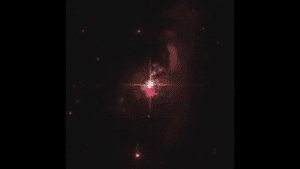TAG: GS 3: SCIENCE AND TECHNOLOGY
THE CONTEXT: The Hubble Space Telescope has provided new insights into the symbiotic binary system HM Sagittae (HM Sge), which went nova in 1975.
EXPLANATION:
- This system, located about 3,400 light-years away, continues to puzzle astronomers nearly half a century after the initial explosion.
- Recent observations reveal that the temperature of the white dwarf within the system is increasing, prompting further investigation into the underlying mechanisms.
Symbiotic Binary System HM Sge
- HM Sge is a symbiotic binary system, consisting of a white dwarf and a red giant star.
- In such systems, the white dwarf accretes material from the companion red giant.
- The accumulated material forms an accretion disk around the white dwarf.
- When enough material accumulates, a thermonuclear explosion occurs on the white dwarf’s surface, causing a nova.
- In 1975, HM Sge experienced a significant nova event, brightening dramatically from a magnitude of +17 to +10.5.
- This increase in brightness, equivalent to 250 times its original luminosity, made the star visible to smaller telescopes and captivated astronomers worldwide.
- Unlike typical novae that dim quickly, HM Sge remained at peak brightness for years, only starting to fade in the mid-1980s.

HM Sge, imaged by the Hubble Space Telescope. The nebulosity that surrounds the system is material puffed off by the red giant.
Ongoing Anomalies and Observations
- Since the nova, HM Sge has not behaved as expected.
- It has experienced periods of dimming and brightening, deviating from the typical post-nova behavior.
- Recent Hubble observations have revealed a strong emission line from ionized magnesium, indicating a temperature increase of the white dwarf from 200,000 degrees Celsius in 1990 to 250,000 degrees Celsius.
- This makes it one of the hottest known white dwarfs, despite the system’s overall dimming.
The Role of the Red Giant
- The red giant in HM Sge is a Mira variable star, characterized by periodic pulsations roughly every 534 days.
- The dimming observed since the mid-1980s may be due to either a mass-loss event from the red giant, creating dust that obscures light, or the 90-year, non-circular orbit of the binary system, which periodically increases the distance between the two stars, reducing material transfer.
- Currently, the stars are separated by approximately 40 astronomical units (AU).
Insights from SOFIA
- NASA’s now-defunct SOFIA observatory, which carried an infrared telescope on a Boeing 747, detected emission lines from water vapor in the accretion disk of HM Sge.
- This was the first detection of water vapor in a symbiotic binary, providing a means to measure the properties of the accretion disk.
- The water molecules were observed moving at 29 kilometers per second, likely due to their motion at the disk’s edge.
System Evolution and Future
- Goldman and Sankrit’s team has concluded that HM Sge quickly settled into a “new normal” after the 1975 nova, with a slow decrease in brightness punctuated by fluctuations.
- The system is expected to continue this behavior for many years until the stars’ orbits bring them closer again, potentially triggering another nova event.
Long-Term Fate of HM Sge
- The red giant will eventually follow the white dwarf’s evolutionary path, becoming a white dwarf after shedding its outer envelope.
- This process will cause gravitational upheavals, possibly bringing the two white dwarfs closer together.
- A collision between the two could eventually result in a Type Ia supernova, but this event is projected to occur hundreds of millions or even billions of years in the future.




